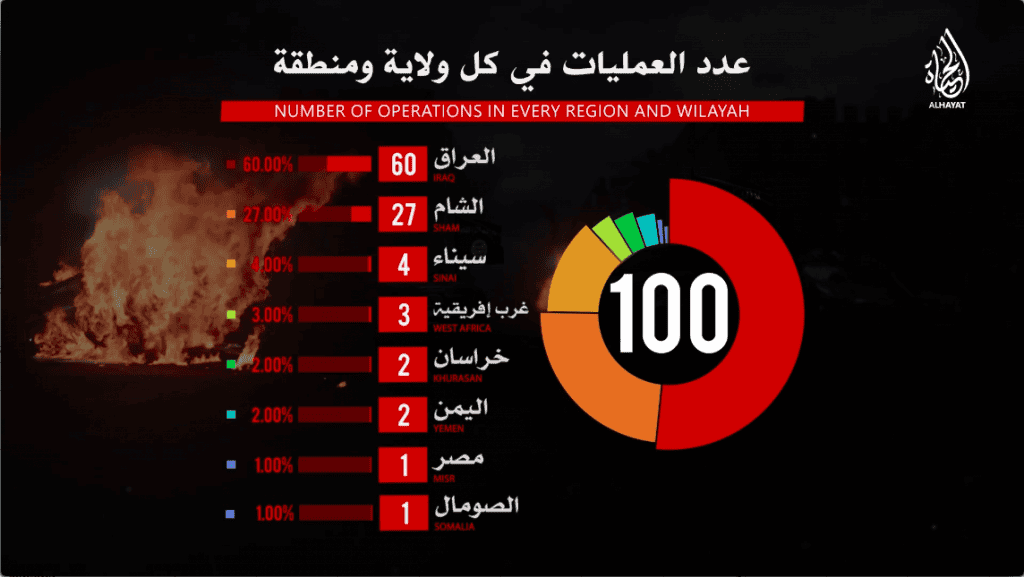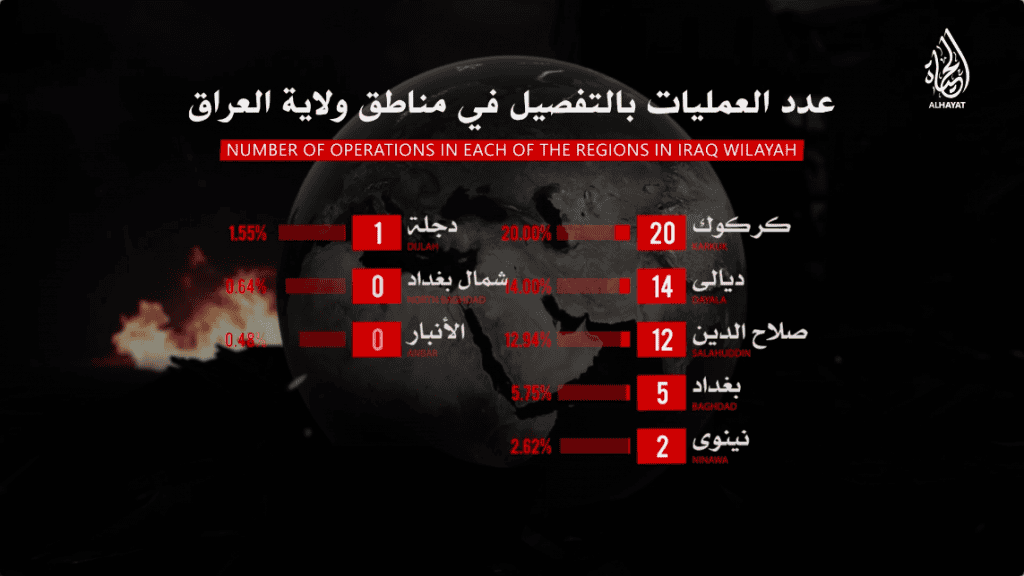On Nov. 11, the US-led coalition in Iraq and Syria released two statements concerning recent operations against the Islamic State. Some of the raids targeted Islamic State leaders responsible for running the jihadists’ insurgency in Iraq, including in the areas most affected by their violence.
On Oct. 30, Coalition-backed Iraqi security and counterterrorism forces “conducted multiple strikes” on Islamic State targets on the Khanukah Mountain in the Salah ad Din Province, north of Baghdad. Combined Joint Task Force – Operation Inherent Resolve (CJTF-OIR) claims that five “senior” Islamic State leaders and 30 “other militants” were killed in the strikes.
CJTF-OIR adds that the jihadists “were responsible for overseeing operations conducted within Salah ad Din, Kirkuk, Ninewah and northern Anbar provinces.” And their personnel have helped “coordinate vehicle-borne improvised explosive device attacks in Sharqat and Qayarrah that injured civilians, in addition to numerous attacks targeting ISF [Iraqi security forces], Iraqi civilians and infrastructure within Salah ah Din and Kirkuk provinces.”
According to the Islamic State’s self-reported data, the jihadists are especially prolific in the same provinces listed by CJTF-OIR.
Islamic State’s claimed operations
In early August, the self-declared caliphate released the first episode in a new series of videos titled, “Harvest of the Soldiers.” A new installment has been produced every week since. The videos are somewhat crude and cartoonish – a far cry from the jihadists’ slicker productions. But the videos purportedly provide a concise summary of the group’s operations around the globe, including data on the location and types of attacks, casualties and tactics employed.
FDD’s Long War Journal cannot independently verify the figures. Press accounts corroborate some of the attacks, but many of the affected areas suffer from a dearth of third party reporting. The Islamic State may also exaggerate the efficacy of its operations, claiming there were more casualties than was really the case.
However, FDD’s Long War Journal assesses that the statistics provided in “Harvest of the Soldiers” are generally consistent with the scale of the group’s operations. The tallies below are based on the most recent six weeks of claims in the Islamic State’s “Harvest of the Soldiers” series, covering the period from Sept. 27 to Nov. 7.*

“Harvest of the Soldiers” includes statistics on the number of operations by region.
The Islamic State has built an international network, but the mother organization is still predominately based in Iraq and Syria.
The figures provided in the “Harvest of the Soldiers” video series testify to the primacy of these two jihadist battlefields. During a six-week period (Sept. 27 to Nov. 7), the self-declared caliphate claims to have carried out a total of 659 operations, for an average of about 110 per week worldwide.
Nearly half of these were in Iraq (313 attacks, or 47.5%), with another third in Syria (217, or 32.9%). The Islamic State’s Khorasan “province” (based in Afghanistan and Pakistan) purportedly conducted the third highest number of operations (56), followed by jihadists in the Sinai “province” (39) and then Somalia (10), West Africa (10), Yemen (9), Libya (4) and finally mainland Egypt (1).
Not all operations have the same level of impact. The Islamic State’s claimed operations range from targeted assassinations by snipers, to bombings with improvised explosive devices (IEDs), to multiple near-simultaneous suicide bombings and “wide-scale” assaults.
The Sunni jihadists say these 659 total operations resulted in a staggering 2,770 total casualties around the globe during the same six-week timespan. As expected, the highest totals were recorded in Iraq (999 dead and wounded), Syria (924), the “Khorasan” (615) and West Africa (111), with the other “provinces” of the so-called caliphate reporting far fewer casualties.
Claimed operations in Iraq
A closer look at the statistics offered in “Harvest of the Soldiers” for Iraq reveals that the KRSC had good reasons to warn of the jihadists’ resilience.
As noted above, there were a total of 313 claimed operations in Iraq from Sept. 27 to Nov. 7. Within Iraq, the Islamic State’s self-reported data indicate that the jihadists have been most active in Kirkuk.
Over the six-week span, the group says 101 operations were carried out in Kirkuk. This is about one-third of the total activity in Iraq. The next four highest operational totals were in Diyala (60 claimed operations), Salah ad Din (52), Anbar (48), and Baghdad (20).

The jihadists unleashed several suicide bombers in residential areas, including Sadr City, earlier this month. The Islamic State claimed in a message released online that more than 50 people were casualties of those bombings. (See the Islamic State message on the right.)
A string of attacks in Baghdad in early Oct. and early Nov. helped drive the Islamic State’s claimed casualties. Again, measuring casualties is difficult and the organization may have reasons to exaggerate. But from Sept. 27 to Nov. 7, the Islamic State claimed 999 total casualties from its operations in Iraq. The highest number of casualties (dead and wounded) were claimed in Baghdad (245 people), Kirkuk (230), Salah ad Din (159), Anbar (131) and Diyala (122). These same five provinces also had the highest total number of operations, though Baghdad witnessed fewer than the other four. The operations in Baghdad targeted densely-populated civilian areas, which likely drove up the reported casualty figures for that area.

“Harvest of the Soldiers” provides statistics by province in Iraq and Syria.
The “Harvest of Soldiers” video series includes other statistics showing that these same provinces are the most frequently targeted. For instance, the Islamic State says its men destroyed 201 vehicles of various types across Iraq during the six-week span. The highest totals were offered for Kirkuk (69 vehicles destroyed), Salah ad Din (41), Diyala (39), Anbar (22) and Baghdad (12). (An additional 12 vehicles were purportedly struck in Dijlah.)
KRSC’s warning in early November

Earlier this month, the Kurdistan Region Security Council (KRSC) warned that there has been a “reemergence of VBIED-based attacks in Kirkuk and Mosul,” while [t]argeted assassinations” and “attacks on electricity infrastructure continued unabated.” On Twitter, the KRSC also provided some details concerning these attacks, which included “[a]t least 40 IED incidents.”
The KRSC’s reporting is consistent with the Islamic State’s claims. During the six-week period from Sept. 27 to Nov. 7, the Islamic State claimed more attacks in Kirkuk than in any other province of Iraq. The group also said that its jihadist killed or wounded more people in Kirkuk than in any province, with the exception of Baghdad.
The US-led coalition and its Iraqi allies have continued to hunt down senior Islamic State leaders and middle managers. But the group continues to wage a prolific guerrilla war in Iraq more than 15 years after the ouster of Saddam Hussein, indicating that the jihadists have a deep bench of personnel.
*FDD’s Long War Journal is compiling a summary of all of the data offered in the “Harvest of the Soldiers” series, but this summary focuses on six weeks of Islamic State reporting.







